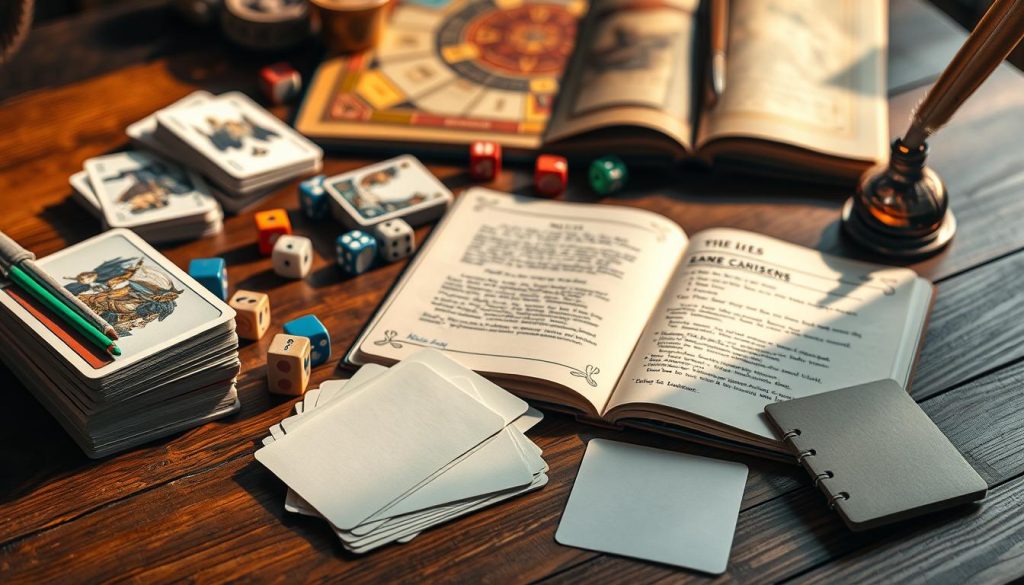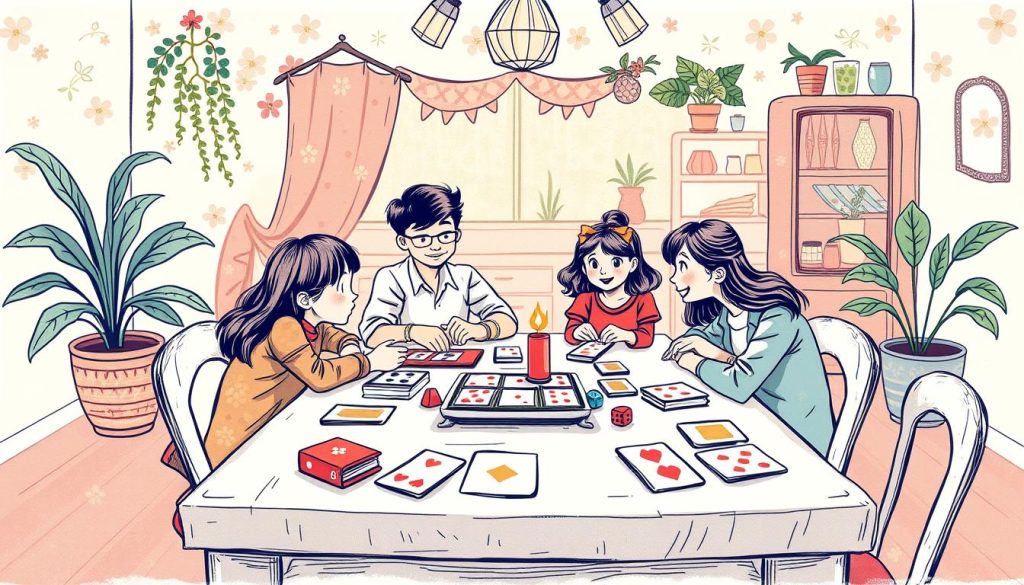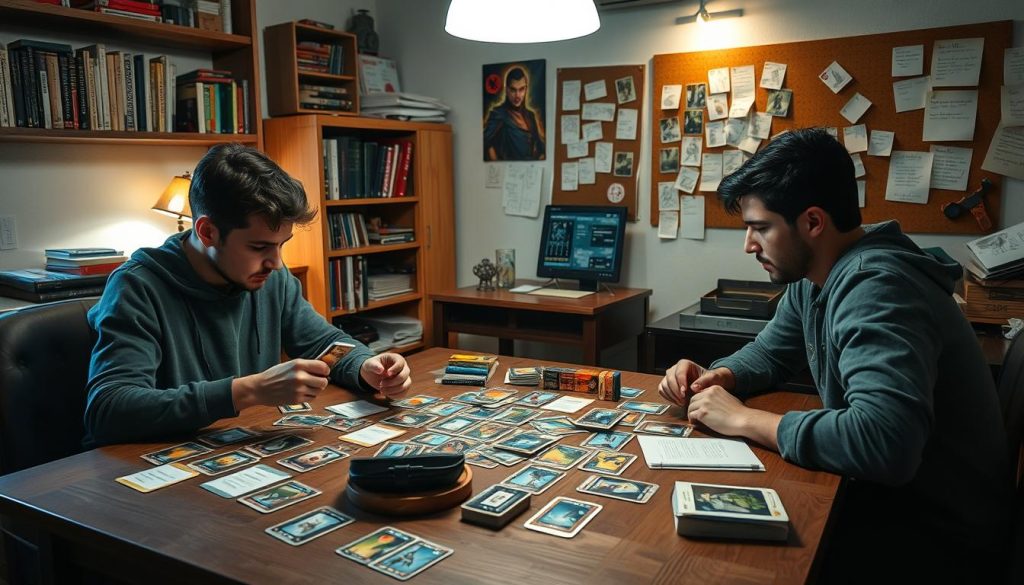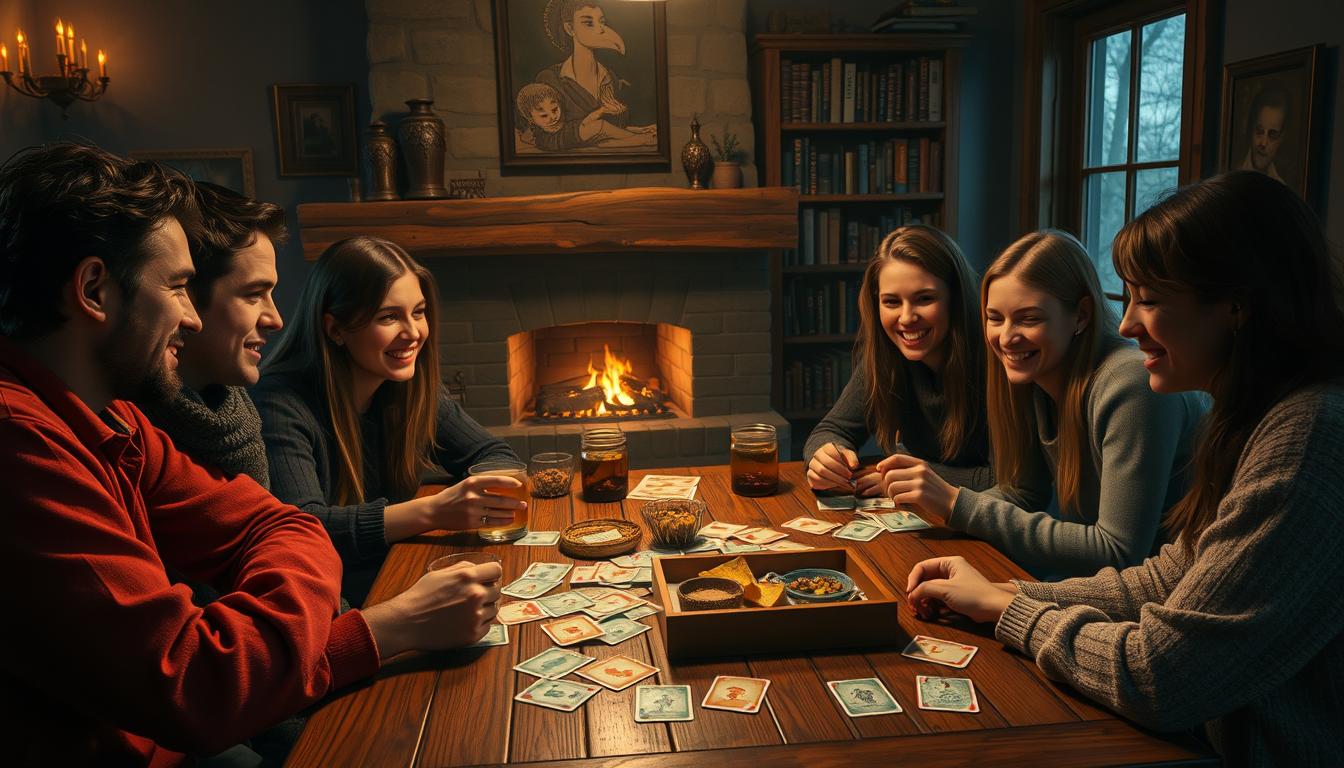Imagine turning a dull game night into a fun adventure with DIY card games. Custom card games open up a world of fun that’s all your own. They’re a great way to bond with friends and family while showing off your creativity.
Making your own card games is more than just fun—it’s about creating memories. With a little creativity and some basic supplies, you can make a game that shows off your personality. These games are special and can become a favorite activity for your group.
DIY card games are perfect for sparking conversations, testing your strategic skills, or just having a good time. You can make games for any occasion, from simple party games to complex stories. The best thing is, you get to decide how the game goes.
Are you ready to make your social gatherings more exciting with homemade card games? This guide will show you how to design, test, and share your own unique games. Get ready for a fun journey into the world of DIY card games.
Why Creating Your Own Card Games Brings People Together
Card games are more than fun. They connect people through creativity and shared dreams. Making your own card games can make any gathering special.
Creating card games has special social benefits. When friends and family make their own games, they work together. This makes their bonds stronger and their communication better.
Building Social Connections Through DIY Gaming
Homemade card games offer many benefits:
- They help people talk more openly
- They improve problem-solving skills together
- They create lasting memories and jokes
- They build teamwork through game design
The Psychology of Shared Creative Experiences
DIY game design makes people feel good. It boosts empathy, thinking skills, and a sense of achievement. Playing custom card games becomes a special way to bond.
By putting time and creativity into card games, groups make fun moments into lasting memories. These moments strengthen their bonds and create unforgettable experiences.
Essential Materials for Making Custom Card Games
Starting your own card game means getting the right stuff. It doesn’t matter if you’re new or have experience. The right DIY game supplies can really help your project.

Now, let’s look at the main things you need to make your card game real:
- Cardstock paper (recommended weight: 80-110 lb)
- High-quality color printer
- Laminating sheets for durability
- Cutting mat and precision trimmer
- Design software (like Photoshop or Canva)
Experts say using top-notch materials is key. Thick cardstock makes your cards last longer. Digital tools help make your cards look amazing and grab players’ attention.
If you’re watching your budget, there are cheaper options. Craft stores have good deals on card game stuff. You can also find DIY game supplies online at Amazon and game design sites for all levels.
Pro tip: Get a corner rounder for a pro look on your cards. Special inks or clear sprays can also protect your game pieces.
Homemade Card Game Ideas for Party Entertainment
Adding creative card games to your party can make it unforgettable. The right game can start conversations, make everyone laugh, and create memories. It’s a great way to connect with friends and family.
With new card game ideas, any party becomes more fun. They work for big or small gatherings. Custom games offer endless fun for everyone.
Quick-to-Learn Party Games
Quick games keep the fun going and everyone entertained. They’re perfect for groups of all skill levels:
- Word Association Challenge: Players make funny connections
- Rapid-Fire Trivia: Quick questions test your knowledge
- Gesture Guess: Mix card prompts with acting
Team-Based Card Challenges
Team games foster teamwork and friendly rivalry. They help groups bond and share exciting moments:
- Collaborative Story Cards: Teams create stories together
- Secret Mission Game: Groups work on hidden tasks
- Collective Strategy Rounds: Teams plan together
Drinking Game Variations
Drinking games add fun to adult parties. Always remember to drink responsibly. Offer non-alcoholic options for everyone:
- Truth or Dare Card Edition
- Themed Challenge Rounds
- Interactive Penalty/Reward System
These homemade card game ideas make any party memorable. They offer fun, interactive games that bring people together.
Transforming Classic Card Games into New Adventures
Card game fans love to make old games new again. This makes game nights special and fun. It’s all about finding new ways to play.
Updated card games bring new challenges and surprises. You can mix up the rules or blend different games. This makes the game night exciting for everyone. Here are some ways to make classic card games new:
- Add storytelling elements to traditional matching games
- Incorporate role-playing components into standard card mechanics
- Create collaborative challenges within competitive frameworks
- Develop unique scoring systems that change game dynamics
Start with what you know when making new card games. Players like games that feel familiar. For example, make Go Fish into a mystery game or Uno into a story game.
The secret to great card game changes is to be creative but keep it simple. Try new rules, but make sure the game is still easy to play. You want it to feel new but still fun.
- Test your game variations with different player groups
- Gather feedback and refine game mechanics
- Keep the core enjoyment of the original game intact
With a little creativity, you can make any classic card game exciting again. It’s a great way to bring people together in new ways.
Strategy-Based Custom Card Game Concepts
Creating strategy card games needs creativity and planning. Players enjoy deck-building games that test their strategic thinking. These games offer unique experiences.
To make a great strategy card game, start with basic design rules. Deck-building games let players build their own strategies. They do this by choosing and combining cards.
Deck-Building Fundamentals
Good deck-building games have a few key things:
- Diverse card types with special abilities
- Clear rules for getting new cards
- Smart use of resources
- Balance in card power
Point System Creation
Point systems make games more exciting and competitive. Designers should make scoring simple yet rewarding.
- Set clear win conditions
- Offer many ways to score points
- Make sure point values are fair
Balancing Game Mechanics
Great card game mechanics need lots of testing and tweaking. Players like games that are fair but still challenging. They want games with many ways to win.
Remember, the best strategy card games encourage players to try new things. They learn and find their own way to play.
Family-Friendly DIY Card Game Templates

Making fun family card games is easy. Just follow a few simple steps. You can make games that teach and entertain everyone. These games are great for learning and fun together.
First, think about what you want your game to teach. Games for kids often help with:
- Vocabulary expansion
- Mathematical reasoning
- Historical knowledge
- Problem-solving skills
Designing your game needs careful thought. Make sure it’s fun for all ages. Use simple words and pictures to help everyone understand.
Here are some important things to remember:
- Make levels for different ages
- Use bright, fun designs
- Add interactive parts
- Keep the rules easy to follow
Family card games make learning fun for everyone. They help families bond through play and creativity. This way, you create lasting memories together.
Creative Writing and Storytelling Card Games
Storytelling games turn game nights into exciting adventures. They unlock imagination and challenge players’ skills. They also create unforgettable moments.
Creating storytelling games needs careful design and game mechanics. These games offer a fun way to explore stories. They let players dive into different narrative paths.
Character Development Cards
Character development games let players build complex characters. They use cards that suggest traits, backstories, and motivations. These cards help players:
- Make unexpected character profiles
- Explore different personality traits
- Practice creative storytelling
- Challenge old ways of creating characters
Plot Twist Elements
Plot twist cards add surprise to storytelling games. They make players think and adapt quickly. They teach players to be flexible and creative in storytelling.
- Change story directions
- Encourage spontaneous storytelling
- Make stories exciting and surprising
These games are great for writing workshops, game nights, or team-building. They offer a fun way to create stories that entertain and inspire.
Tips for Testing and Refining Your Card Game

Making a great card game takes more than just ideas. Playtesting is key to making your game better. It turns your idea into a fun game for everyone.
Begin by finding a group of people to test your game. They should have different skills and love playing games. Make a plan for testing that covers important parts of the game.
- Track player engagement and enjoyment levels
- Observe how quickly players understand game rules
- Note any confusion or strategic bottlenecks
- Measure game duration and pacing
When testing, ask for specific feedback. Ask about game balance, rule clarity, and fun. Write down everything you notice. Watch for moments when players seem upset or bored.
Improving your game is a never-ending job. Be ready to make small changes based on what players say. You might need to change rules, how cards work, or the game’s balance. Remember, making a great game takes time and many tries.
Your aim is to make a game that’s easy to play and fun. Listen to what players say and see each test as a chance to make your game better.
How to Share and Teach Your Homemade Games
Sharing homemade games is all about being excited and clear. When teaching your card games, make sure everyone feels at ease. Give out a simple rule sheet with pictures to help understand the game.
Hosting game nights is an art that needs patience and joy. Break down rules into easy steps and show each part with examples. Some people learn better by seeing, others by hearing. Change how you teach to fit everyone’s learning style.
Use social media and local gaming groups to share your games with more people. Make short videos or host workshops to show how you made your game. Ask for feedback to make your game even better and grow a community around it.
Teaching games is about making it fun. Keep things light, answer questions, and be open to new ideas. Your love for the game will attract others to join in the fun.

